– JOINT ARTICLE WITH PROF SENER USUMEZSOY – THE REDSKIN ! –

The US must first prevent the entry of new energy suppliers into the market in order to fund large-scale Shale Gas investments and then to evaluate the new horizon that opens up its front. The US will fully use this opportunity to overcome the ongoing global deflationary crisis and to leap to a new model of capital accumulation.
In 2016, the US began to export LNG to the Middle East’s oil-rich and natural gas-rich Sunni Arab countries. You did not misread: it’s not the Middle East which is exporting gas to the US, the US is exporting gas to Middle East!
Following the “LNG impressario” nicknamed Sharif Souki who got the sack with thanks and appreciations, the giant tankers are coming to Cheniere’s Sabine terminal in Luisiana to load gas one after another. These tankers cross the Atlantic Ocean, turn the Cape of Good Hope, then they cross the Indian Ocean, the Persian Gulf with the escort of US navy, to deliver their load to Kuwait harbor.
Kuwait and UAE hold already 12 percent of total world oil reserves and 4 percent of natural gas reserves. So why are these two countries buying natural gas from the US, beyond two oceans?
Because, for those -so-called- Arab “countries” that are governed like grocery, there is only one criterion for doing or not doing a business: the cost… If the cost of the technology needed to operate “tight gas” reserves at a depth of a few hundred meters exceeds the price given by Cheniere, there is no sense for them to enter this business. So these countries, in fact, are not literally “countries”. Because they have no any real concern for future survival and existence throughout history. They actually do not bear the notions of “nation”, “people”, “state” and so on, in the very sense to what we understand by these term.
The following image is an aerial photograph showing the night view of Kuwait and Iraq. You see the natural gas burning in the wells of Iraq at just 150km from Kuwait Port, where the tankers coming from the US are docking to deliver the imported gas. The cost of US gas to Kuwait ranges from $ 3 to $ 5.5 (per million BTU), excluding freight cost. In other words, a tanker docking to the port of Cheniere is filled from 9 to 15 thousand dollars. And the yearly value of gas burned in the wells that you see in this picture, just 150 km away, is worth about 1.8 billion dollars.
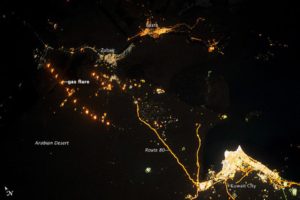
The table below shows the amounts of LNG loaded from Cheniere in 2016 for deliveries to Kuwait, BAE and Jordan:

This also tells us that there is a big dent in the political geography of the region. The ruling elite seems to be trying to save time for evacuation in a sinking ship, rather than tackling to seal the hole… When the day comes, they will leave wreckage behind them and flee to the West.
In our previous articles we have already mentioned that throughout the Shale Gas Revolution in the US the geopolitics of the Middle East was turned upside down. The dynamics are now just the opposite of what we got used to know by OPEC geopolitics. In summary:
– In the last ten years the US ruling class has realized that they own the world’s largest energy reserves. And in the last two years, from being a net energy importer, US has shifted to be a net energy exporter. And it is consequently now becoming the world’s largest exporter of energy, leaving Saudi Arabia and Russia behind… This transformation leads to drastic changes in domestic and foreign politics of the United States. In this article we will study the new horizon that opens up in the context of GNR technologies, to the US becoming a new energy giant. In order to -first- fund its huge Shale Gas investments and then to evaluate this new horizon, the US must first prevent the entry of new energy suppliers into the market. The US will use this opportunity up to its end to overcome the ongoing global deflationary crisis and to leap onto a new model of capital accumulation.
– Holding the world’s second largest energy reserves, Russia is the main energy supplier of the whole continental Europe, as well as China. With its geographical position and already established pipeline infrastructure, besides selling arms it keeps its economy floating mainly by exporting energy. The Russian economy does not tolerate the entry of any new supplier into the market. For Russia, protecting and expanding the energy market, on which it is already dominant is a matter of life and death.
– It is not possible for the US to intervene into the Russian energy hinterland, which is already well functioning with its strong infrastructure – if both country’s geographical locations and military potentials are taken into consideration (Western tricks in Ukraine will probably fail too). Likewise, it is not possible for Russia to intervene into US’s natural gas exports by tanker ships.
– However, it is both the two superpowers’ common interest and it is within their mutual military-political capability to prevent the emergence of a third supplier!
– The world’s third largest and conventional (easy-to-operate, near-surface) oil and gas resources are located around the Persian Gulf. On this reserve Sunni Arab states, Iraqi Shiites and Shiite Iran are seating.
– So, the US-Russia hookup in the Middle East is the logical consequence of this constellation. The purpose of this partnership is to mess up the Gulf energy reserves.
– The China factor makes no change in this equation, on the contrary it confirms: Russia geographically dominates the way to China. The US dominates the Strait of Hormuz, the Malaka Strait, the South China Sea, the Philippine Sea, the Japanese Sea, and so on. Even if China opens one or more holes in this seawall, this makes no change in the situation as long as the US holds the Strait of Hormuz: The flow of energy to China will continue to be under US and Russian control. For this reason, there are reports that China is heading to operate its own resources, trying to develop government-sponsored Shale Gas technology, opening about 700 wells in the Sichuan basin, and lowering the cost of opening new wells as it gains experience. It is also reported that in a few years China might succeed to avoid its import dependency should it continue developing its Shale Gas industry at this speed. So it is obvious that China undertakes LNG independence as a national and vital issue.
So to conclude, there is no logic at sight to presume for China could engage against the US-Russian alliance -neither at sea nor at land- for Middle Eastern resources.
The three biggest global powers (US, Russia and China) are energy self-sufficient, the two of them (US and Russia) rely their economic futures and development plans to export incomes of their energy surplus, while the fourth largest power (EU) is (almost) completely surrounded by the Russian gas (In our previous articles we have already told that Algerian gas had already become the Russian gas, by the purchase of Sonatrach shares by Gazprom).
From Gold Anchor to Energy Anchor
For Russia -which funds its post-soviet recovery mainly on energy export- the sensitivity of the subject is clear, a well known fact. However why the subject is also so sensitive for the United States? In free market order some companies may have invested in a new technology, the costs may exceed the revenues, they may mis-predict future, so they may fail… But things are not so simple. This is also a national and vital issue for the United States. Here is the reason:
– From the end of WW II until the collapse of the Bretton Woods system, Dollar was a commodity currency. So it’s value was based on gold. The US had collected a very strong gold reserve in the war, usurping the gold that Nazi and the Japanese Empire usurped in the lands they occupied. So the post-war reconstruction was financed under the US hegemony as countered by this reserve. On August 15, 1971, Bretton Woods system was abolished. But as the gold anchor was released – as then many would have expected, rather than getting collapsed – the dollar’s global benchmark character grew even stronger over time. The release of the dollar from gold anchor also allowed the US to gain a huge seigneurial income from the 80s, granting a great flexibility of borrowing to FED, letting it to manage the financial development that converted the whole world into a global giant casino.
However, since 1971, the dollar has not maintained (and even reinforced) its reserve currency status being really a “fiat currency” (“fiat currency” is the money printed by law, “commodity currency” is the money printed as against a commodity reserve), despite to the general opinion and the neo-liberal propaganda. The energy market, and the oil in particular, became the unofficial commodity anchor of the dollar. The energy commodity anchor has brought dollar hegemony up to today. The dollar has never been exactly a “price currency”. If it were, both the EU member and the Euro using countries, Norway and Germany would not be trading oil by using dollars!
When we connect this story today’s Shale Gas issue, we can see the importance of exporting its own gas surplus for the US. Thanks to Shale Gas technology, the US has found an endless gold mine. The dollar’s global “benchmark” status will be boosted by the exports of energy surplus to all-geographies that are beyond the access of Russia.
Can Russia and China not do the same move?
The lack of access to hot waters, which is the eternal problem of Russia, is again hindered here. Russia will try to protect and expand its market through pipelines. But it can not create new markets for itself like the United States does. It can however develop a profitable cooperation for both sides by opening the Arctic Seaway for its own use and for to the US – we will discuss this Arctic alliance of two superpowers in more detail below.
China is still beginner in deep Shale drilling technology. In a few years it can develop it to the extend to fulfill its own need . But catching up an export potential that would pose a threat to the US with building its liquefaction terminals and ports would either be impossible or take a lots of time – especially when considered it is surrounded by the US allies like Japan, Philippines and another energy-wealthy country like Australia.
The Capitalist Revolution
The mode of accumulation through globalization of financial capitalism based on information technologies that has been going on since the ’80s has been exhausted. However, it would be a bit of a habit to deduce a global war scenario out of this impasse.
The danger of war increases when there is no a new accumulation model at sight and the resource and market struggle is sharpened.
Today however -unlike the previous prewar periods- the developed world has new technological possibilities to fund a new capital accumulation model radically transforming the way of life of its own societies. If capitalist productive forces can actualize these possibilities as the economic activities of a new accumulation model, a new welfare reconciliation can be established between the classes of advanced countries. So that way wars can be contained in backward geographies.
The tractor of this revolution (or transformation) is not the working class but the logic of capital. Nevertheless, we still need to apply Marxist formulas to better understand what’s happening:
According to Marxist formula, revolutions emerge in historical moments when the antagonism between productive forces and relations of production reaches to an unsustainable point. Until that moment, the already existing forms of relations of production can coexist together with the newly emerging productive forces in a continuous crisis. It is only if and only if the “new productive forces” could envisage and engage in a new and more efficient relations of production which would lead a rise in the average welfare and equality resolving the crisis, that then it would become a “revolutionary class”.
Hence, there is no “telos” (there is no any “good” coming from the spontaneity of history, a concept of human life that goes to the right and better direction..) in neither Marxist dialectical materialism nor in Hegelian logic. Neither Hegel nor Marx are teleological, when correctly understood. Embedding teleology into the dialectic logic is the PR strategy of swagger overlord leftists predicating mysticism to romanticize social and political theory. So the right-wing and liberal scholars add in their turn, another misconception to that of swagger leftists’, presenting -as if- this mysticism and romanticism was the weakness of Hegelian-Marxist system of thought.
Professor Zizek explains this problem of causality in teleology and history as a retroactive paradoxical process in which the causes to confirm the actual reality could only be found after the effects founding that reality. In the logic of historiography effects come prior to causes. So there is no fate. There is no any entity over-determining the human will (“There is no Big Other” – Professor Zizek). In every historical event people – even if they might be unconscious of what they really want – have full initiative of the event.
So, no revolution can happen within that scrap logic of anarchism saying “Let’s first turn down the power edifice, then something good will eventually happen”, neither by the way Doctorists’ – the followers of Doctor Hikmet Kıvılcımlı and Gordon Childe, who are not anarchists but similarly relying on a – dogmatic consideration of the “barbarian-communal soul” (as opposed to Lewis H. Morgan and Arnold Toynbee’s progressive positions). So to conclude a lesson for the leftists: if you are not into a very sophisticated social engineering, there can be any kind of disaster other than revolution (fascism, counter-revolution, and so on..).
This hysteric revolutionary position without having in mind a clue about what their revolution would bring (the case of pro-tribal-anarchists, Doctorists and so on) also creates at its opposite end the similarly mysticism-embedded and dogmatic status-quo conservatist stance like the liberal’s, environmentalist’s, naturalist’s, civil-society pioneers, proclaiming “we live in the best possible world, whatever we do spoils it, we mustn’t touch on it”, like that of Professor Pangloss-Leibnitz optimism. So both positions are alike in standing against human mind. However a progressive political project today must first start by refusing any fixed predominant, over-determinant structure like nature or some other entity that protects or keeps the world in its current state.
What are these “Productive Forces”?
In the sociology of Marx the social classes (bourgeois / proletarian / lumpen, feudal lord / peasant, master / slave, etc.) are cartoon-like abstractions which do not exactly correspond to real persons. Nevertheless contrary to the claims of nowadays’ sociologists, these cartoon abstractions – do not weaken but instead – reinforce Marx’s system of thought. These abstract class roles are necessary assumptions to establish coherence in modeling and understanding the dominant relations of production (capitalism, feudalism, ancient slave order, etc.).
When we look at the level of actual individuals, it is seen that people enter and exit these class roles, change roles, and even assume different roles together and at the same time. Marx himself often reminds the reader that this class identity is an abstraction. Marx has also theorized the problem of adherence of real people – no matter from what class it is – to the role imposed by the system: the theory of alienation. Capital is not just the enemy to proletarian, it is also the enemy to capitalists. What we call capital is not simply money, machinery, or such material objects, but an historically particular form of social relations that imposes its peculiar roles on people.
So who are these “productive forces” that have the potential to become “revolutionary political subjects”?
Last year Professor Zizek had published an article entitled “The Sexual is Political”. As a perfect philosophical masterpiece, this article was perhaps one of the most hatred articles of the professor since it provided the most compressed and powerful criticism ever written against Judith Butler, Alain Touraine style pluralist identity politics (Click Here: Prof. Slavoj Zizek, “The Sexual is Political”, The Philosophical Salon, 1 August 2016).
In this article Professor Zizek instills anew Hegelian graft to Marx: it is a mistake to describe what we know as class conflict as an antagonism between the two well-functionning classes (the bourgeois and the proletariat) of the system. These two actually constitute the systematic whole. The main dialectical antagonism however is between the systematic whole and people left apart from the whole, that can not be included in the whole.
Here, what come first in mind are the lunatics, criminals and lumpen-proletariat. The newly proposed categories such as “lumpen-bourgeois”, “self-programming laborers”, affective laborers” may also be included in the list.
The precondition for these outsiders for becoming heretics to engage into a revolutionary conflict is for them to take a position against the whole (that is, not only against the bourgeoisie but also against the proletariat) and – at the same time – having a universal project defining new satisfactory roles for all these determinate parts of the existing system!
So if the job was to write a tailored manifesto (communist manisfesto) the revolutionary subject is to be considered as the proletariat if and only if this proletariat is defined within the differential process of capitalist proletarianization (producing an increasing number or outsiders over time). But keeping in mind that the proletariat is just an abstraction that completes the modeling, we must question how these two thresholds are to be passed:
1) In what situation do real people become “productive forces”?
2) In what situation will the productive forces become “revolutionary political subjects”?
Conditions for a Revolutionary Match
Historians refer to a period when newly discovered technology instruments peculiar to feudal mode of production (like cranes, mills, spools, weaving looms, etc.) had remained idle, unused and left aside to decay, during the fall of the Roman Empire.
The “machine breakers” that appeared during the early times of industrial capitalism are a similar phenomenon.
In the 90’s when Chinese industrialization made a big leap, there had been a period of years when newly imported CNC countertops remained idle or left aside without even their packages being opened, to avoid artisans and handworkers like modelers, mold makers, to remain unemployed …
Examples can be multiplied. If we embrace this phenomenon into a historical materialist form, we can speak of certain historical periods in which new means of production can not meet people with skills and motivations to use them, and thus remain idle despite their inventions.
In capitalist mode of production, means of production (fixed capital, “C”) do not produce “value” on their own. The “value” is produced when labor power (variable capital, “V”) meets with means of production.
So, what prevents this meeting?
The well-memorized Marxist historical materialist formula explains this mismatch as “the old relation of production relations becoming trammel, impediment, to new productive forces”: the power to impose a new model of social relations (a powerful and convincing political project) that will efficiently operate the new means of production has yet to emerge.
Although this article would look to readers as “technology deterministic”, our purpose is, on the contrary, to provoke the reader to think about the rapid change in human-machine interaction in today’s world.
So in what conditions this meeting leads a different model of relationship, instead of reproducing the currently functioning order?
As by definition the labor power is “variable capital”, through changes in employment rates and volatility in labor market, these meetings and detachments are almost always occurring. We also know that increasing detachments in a crisis environment (lumpen-proletarianization) triggers reactionary regressive dynamics instead of creating a revolutionary uprise. So we know that outsiders show at first hand regressive hostile reflexes instead of coming up with an inclusive universal project. Moreover, even when the meetings take place in a crisis environment with a revolutionary will and political consciousness, even such a moment, rather than revealing revolutionary productive forces, it reproduces the format of the relationship of the current order:
– As the regime soldiers captured by Spartacist rebels were treated as slaves …
– Like The 1871 Paris Commune did not know what to do when it came to the banking … in spite of its political / military autonomy and its full possession of the means of production of its time. Banks and financial institutions are the main apparata that recreate the capitalist mode of production through commercializing expectations and trust in the market.
– In 2001 Argentine crisis, workers had broken locks of bankrupted factories and workshops to restart production by themselves. But even this extraordinary productive movement did not lead to a rise in the consciousness that would lead towards a different model of relations of productions. Even in those days when Argentinian people were eating street cats and dogs by starvation, this worker movement restored the old capitalist relations instead of creating any hope for a different model of relationship.
So, for anyone who pretends to be leftist, this question is very important: why does the labor power, even when it is joined to the means of production, it restores the existing relations that are already in crisis instead of becoming a revolutionary productive force? We have to do first the theory of the empirical phenomena ready at hand, namely the failure! Why does a social movement collapses and leads to regression and fascism, without realizing its progressive ideals?
Class out-of-itself
When a class movement claiming to have a progressive mission derails and consolidates the existing relationships, it is vain and misleading to link the causes of such failures to external factors (like that of Prussian Army, imperialism, and so on) or to some unexpected adverse factors (like that of traitors, cowards and so on). Such plea, instead of leading us to make sound analyses for deducing lessons from the failure, would confirm the pathetic impotence of that class movement. We need to look up, instead, at the very first moments of the event, to find the reasons for failure in the initial mental states of people (or masses) where they first rush out to streets. Marx’s two notable Hegelian categories are not enough to think about this situation: “class in-itself” (phase 1: class not aware of its revolutionary potential) and “class for-itself” (phase 2: class with revolutionary consciousness). So we add a third phase, a Lacanian phase, in front of these two phases, which we can name as “ground phase” or “zero level phase” designating that “fantasy class”:
0) class out-of-itself” or “fantasy class”
1) class in-itself
2) class for-itself
The class out-of-itself (phase 0) seems to be paradoxically even more conscious than the class in-itself (phase 1): it believes in the necessity and inevitability of change and is ready to engage in actions, pour into streets or even jeopardize its life. It develops psychological addiction on the natural and primitive enthusiasm of being in a mass movement. The pattern of its actions follows doctrine-action-romance cycle, instead of theory-praxis-reason cycle. Everything they say might be true, so we can not speak of a “false consciousness” here. However, this “consciousness” refers to an unspoken mystical, romantic, hypothetical contradiction that it has not yet into relations of production as a productive force. It is conscious, but it has no interest in its current situation out of this consciousness, which is analogous to what call lawyers: “The litigation rejected by the lack of legal benefit”. That is why it is a fantastic consciousness that is “not in-itself”, but perceiving things outward from itself.
The discussion of Professor Zizek with Sam Kriss revealed a deliberate case of this fantastic consciousness. The method of psychoanalytical critique of ideology developed by Professor Zizek against the liberal-left also explores this “out-of-itself” consciousness: “whatever they say can be true, but still, what do they objectively do?”
The real weirdness of this fantastic state of consciousness is that expression of truths – instead of leading to a revolutionary movement – eventually functions as the affirmation of the current order. Discourses, grandiloquent speeches, bloody talks, relax hearts and make them back to reconcile with everyday life. It is not the content of what is said but the act of articulation (“performatives”) what functions here: rhetoric is skillfully chosen to provoke the most intractable fantasies in the minds of listeners. Adorno has theorized that this mechanism works in a similar way also with art and aesthetics: perfection and harmony in art leads to an enthusiasm, which ultimately reconciles the audiences with the order.
Ruptures in Honor-Labor bond
David Harvey in his speech at Bilgi University (a private university in İstanbul founded by Soros funds) few years ago, emphasized the importance of awareness of every form of labor involved in the supply chains, to develop a socialist resistance: from the farmer until the retail seller, from the factory worker, to the truck driver carrying the goods – as what David Harvey was telling – we should be aware of every kind of labor loaded on the end-product.
However, in the light of the above explanations, we can see now how utterly futile were the warnings of David Harvey: truck drivers closing the roads in the edge of robotic revolution is a similar case to that of Toyota factory workers’ strike in Holland (Toyota factory workers in Holland did a strike to protest the shut down of their factory some years ago) or like workers union leaders coming to endorse Gezi movement in İstanbul and returning home right after having read their declaration in front of the police barricades… All those pathetic examples seem like saying “we have played the theater, we had fun, now it’s time to get back to the real life”, which is nothing about revolution but restoring the order. There is consciousness, there are leftist organizations and they even function in organizational discipline, but the class is “not in-itself”. So the material practices and ideological apparata that are currently operating in everyday life impose and maintain the rationale of the system.
So we have already mentioned the ineffectiveness of technological determinist position: if new means of production (the material/technological component of the revolution) do not match with the revolutionary productive forces (the human component of the revolution), despite the fact that they might have already been invented, they remain idle or thrown out.
This point addresses to Marx and Engels’ criticism of Feuerbach and mechanical materialism.
We then showed the inadequacy of the romantic/hysteric revolutionary position, which emphasizes the human factor alone with examples (the new concept we are proposing to define this situation: class out-of-itself). What is even more frightening that being condemned to failure, this position consolidates the existing regime and even gives way to reactionary-fascist counter-revolutions under the manipulation of authoritarian and populist politicians.
This point addresses to Marx’s critique of idealism and utopian socialists.
Marx’s position, however, is above these two positions, that is the Dialectical Materialist position.
So let’s ask again now our last question with more elaboration:
– How could it be possible to meet new means of production that can not be operated within the existing mode of production, with whom who are able to use them?
– If this meeting takes place, will these new productive forces that are functioning in conflict within the existing relations of production, become automatically revolutionary? Or does this revolutio+missio+nary (both practical and mental) transition depends on some extra conditions? If so, what are these conditions?
The emergence of new productive forces (a successful match of material/technological component to the human component) promises a new type of human being. This human type is probably an outsider, an adverse personality that is incompatible to its surroundings as it can not use its productive capacity – even if it already exists – in today’s norms. Therefore, the social order and its political, moral and legal regime that will be aimed by revolutionary productive forces, will most likely be a nightmare, not only for the right-wingers, but also for the leftists of today’s world. This “revolutionary political subject” characteristics, which we can not fully describe today, is most likely an object of hate for both today’s rightists and leftists.
The relationship between labor and honor is a historically-culturally established link that emerged with the rise of feudalism and Christian morality. In slavery, the laborer (the slave) does not derive a sense of honor over its labor. Slave’s labor is the honor of its master. So, any phenomenon that has historically-culturally emerged can once again be abolished when its conditions of existence disappear within the dialectical logic of historical materialism.
And there are indications that this bond has begun to break today.
Social classification appeared with the separation of the mental labor from manual labor. This separation in the slavery was very precise and sharp:
The master was not the one who was simply ordering what to do. It was the one who also needed to know to use the most appropriate physical and ideological means of production that can reify the needs and necessities of its society, able to figure out and properly decide what to do / not to do, what is necessary / unnecessary and what techniques to be used for things to do. Therefore, the master was both and at the same time a technical engineer, a social engineer, a scientist, a sociologist, a politician, a lawyer and a psychologist and so on. The slave, on the other hand, was just forced to function as a pure material mean of production with all its material and mental existence.
So it is now worth to point out that at the point where we are today, the leftist doctrine needs increasingly to reiterate its “our labor is our honor” statement. Why? Because the only reason to perpetuate many jobs and professions that have already lost their productivity is for the workers to deceive themselves perceiving their activity as their unique source of honor. Today, the most fundamental weakness of leftist doctrine is its inadequacy to figure out a notion other than the labor to which human honor or dignity is to be related. Because of this inadequacy of leftist doctrine in the face of the irreversible rupture in honor-labor bond that today’s individual has no choice but to run into the fascist or religious interpellations.
“Knowledge” as the Ultimate Mean of Production
I will be thought provoking at this point to go one step back and ask “what are these means of production?”
What comes immediately in mind when one says “means of production” are of course the material means of production like tools, machines and so on.
Humans have been using tools ever since the paleolithic era. The first technological apparata of 50,000 years ago – the chipped stones – have evolved into CNC looms, GPS-controlled autopilots, driverless vehicles, robots doing surgeries, over time.
All these artefacts (from chipped stones to robots) are ultimately “material” entities. The vulgar Marxist doctrine assumes that private ownership of these material means lead to social classification and labor exploitation.
But there is a problem with this understanding: these material assets can easily change hands, much easier and often than the changes in mode of productions. These hand-overs can take place within the free market rules (by their “exchange value”), as well as through social movements, regime changes, loots and so on. If the notion we refer by “means of production” corresponds to these material means, history has witnessed numerous changes of hands, breakdowns and remanufactures of such material means until now, like that of 2001 key-crackers in Argentina, machine crackers in the 19th century… So how is it that, despite these changes of ownerships, class-based relations of production had each time get restored?
Here is where the problem is knotted: getting to know how to use a tool doesn’t automatically transfer the knowledge about the production and administration to operate that tool, into the user’s (or worker’s) mind. The worker can not administrate the operation of the means of production as it lacks that kind of knowledge. That is why the transfer of the property of material means of production – namely to the hands of the proletarian class – does not automatically trigger a change in social order. Marx tried to explain this problem with the theory of “alienation”, which is not precise.
How then should we understand the rough Marxist formula that we know as “the socialization of the means of production”? Or how should we revise this formula to fit empirical historical facts?
Every machine is ultimately a project (either on paper or on the screen of a CAD program), and every project is ultimately an idea (image in the brain). The idea turns into a project by getting qualified as “knowledge” (not “information” but “knowledge”!). This qualification is fulfilled by a sagacious, well-directed prediction about the functioning and adaptability of that “idea” into social production / consumption relations. So the transfer of ownership does not directly bring about a revolutionary transformation in the relations of production, since the ownership of material means (by workers), doesn’t automatically transfer the fiction – the goal of producing a certain type of value – to the mind of the worker.
So, what is meant by the socialization of the means of production to invoke a revolutionary transformation of social order are not the socialization of material means The notorious Marxist formula should be revised as the following: every production mean is ultimately a kind of knowledge. Let’s leave aside the liberal and postmodern crap: there is nothing revolutionary or emancipatory about “information society”. What matters is to build a “knowledge society”. Class divisions has emerged in the history by the privatization of knowledge.
Interpassivity and Post-Truth
However, let’s note that what we are talking about here is a precise distinction – and even contradiction – between “information” and “knowledge”. Now we will proceed to explain how information technologies (IT) – rather than enlightening – rusts the human mind.
Contrary to postmodern and liberal assertions, what we call as today’s “information society” has provided rulers more tools and power to restrict, control and privatize “knowledge”: the average individual has lost itself inside the pile of information storage and sorting (in-form-ation) tools it has at hand, as well as losing its ability to associate this uploaded material inside those storage tools, with its social existence (ability to transform “data” into “information”, then information into “knowledge”, and eventually, capacity to derive “consciousness”).
We can compare this phenomenon to the situation of a student who does not have an idea on what it wants to write despite it has a full collection of necessary resources, books and lecture notes on its table to write its homework. This kind of student having no idea on what to write and why it could be important what to write, develops a unique concern to fill its trash can in the name of homework: elaborating a gaudy rhetoric with embroidering and paraphrasing citations (weak academic capacity: high rhetorical anxiety).
This mass accumulation of meaningless “information” into which mankind encapsulates itself rusts also its existing “knowledge”. This phenomenon is denoted by the new term coined by Professor Zizek into political philosophy terminology: “interpassivity”. In such a situation where the will and ability to transform information into knowledge is missing, the knowledge that exists in the place is gradually getting rotten: everyone knows what’s going on – there is no a consciousness problem. But rather than initiating the interactivity deduced by information, individuals generate “interpassivity”. When the information stack can not get converted into knowledge, it begins to swallow the existing knowledge. This sociological condition is expressed by this popular term invented in 2016: “post-truth” (or: post-fact politics).
Keynesianism, Again!
So, under the light of the brief statement above, we can deliberately say the following: in today’s world, there is no a new doctrine, a progressive class movement, any jakoben, Kemalist, socialist, Leninist, etc intellectual movement, a rational world design, a progressive ideology at sight, that is opposing to capitalist dynamics. One may find similarities between the economic depressions of 1930s and today’s, but in the political scene there is absolutely no any similarity to that of 1930s: in 1930 elections in Germany NSDP got 18% as opposed to the 38% total of Leftist, while in 1932 the NSDP was equalized votes, then in 1933 the elections NDSP was overwhelmingly 44%. Within two years, with various manipulations and shock doctrines, the left base in masses shifted to Hitler, since, that time, there WAS a left base which can-shift-or-cannot-shift to Hitler! Today, by contrast, there is no even such a left base which can be subject to such a shift! At that time there was a gigantic success example like the USSR for the masses, which were thrown from one side to another, in hope and ambition. Today by contrast, the masses are much easier to get ruled. Forget about the funny street parties of few years ago. The masses are much in a state of numbness now far from producing any serious social and political project. So the economic crisis is much easier to be managed within the logic of capitalism. So to deduce, the risk of a global war is much farther today than it was in the 1930s.
So what kind of a world does the capital seeks to create today out of which it will be milking its firstling as a new mode of accumulation?
Berkshire Hathaway’s acquisition of BNSF railway company in 2009 with an astronomical price like 26.5 billion dollars, had not took much attention at that day’s financial turbulence. Warren Buffett explained his logic of this purchase with these words: “This is an investment that will keep my company at the top for another century! You do not do bargaining in such cases, you do what you must do, you get it!”. This troubled company causing forest fires, fatal accidents with its obsolete rails and wagons until 2009, brought more than its full purchase cost back to Warren Buffett just in one year – thanks to Shale Gas revolution in 2014. Following the collapse of finance capital, Buffett predicted that a period was getting to its end, in 2009, and the Shale Gas revolution was at sight and a huge infrastructure mobilization will begin soon in the country to model a new capital accumulation model. Since the pipelines that would transport oil to the refineries and LNG to liquefaction terminals have not yet been installed, BNSF’s biggest business now is to transport oil and gas.
This investment of Buffett was in fact the precursor of Trump’s new-Keynesian economy politics. Why is Keynes today on the agenda again? To understand this, let’s first have a look at the cyclic crisis model proposed by Nikolai Kondratiev.
Kondratiev finds out that systemic crises due to insufficient demand (deflation) repeat itself every 70-years. Great and subversive transitions occur at the end of every 70-years. Each 70-years period are also divided into two turnover periods of 35-years from which their transitions are somewhat lighter and more manageable crises.
The first 35-year is the growth period of the real economy. We can understand this as a mode of accumulation depending on a certain set of pioneering technologies. When this first mode of accumulation exhausts (when the market shrinks, when prices inflate by cost inflation, and so on), the capital is withdrawn from the real production, becomes financial-capital and imposes “soft” imperialism, that is, “globalization” to political agency to provide itself geographical freedom of transaction. This “financial” mode of accumulation is once again clogged after spending another 35 years into speculative activities in cross-border geographies. Then after the Schumpeterian “creative destruction” comes to the agenda.
Keynes emerged in the Great Depression of 1929, in such a big deflationary deadlock. He diagnosed what other economists could not see at that time, that the deadlock was a deflationary crisis. As a solution, he advocated governmental fiscal policies such like public infrastructure investments, together with a modest monetary expansion adequate to trigger economic growth. As he convinced Roosewelt, the US had survived the 1929 Depression less intact than the United Kingdom.
Keynes denies neither the Marxist formula that capitalism produces periodic deflationary crises, nor the Kondratiev’s cyclic model, right on the contrary, he could succeed to develop his crises management strategy adequate to restore the system by accepting their formulae as concrete phenomena. He also argues that the war risk can be eliminated if the all the trade partner countries simultaneously apply Keynesian policies in a coordinated way. He also argues the necessity to establish international financial and investment institutions to succeed this coordination. IMF and the World Bank that were established after the War, are the institutions of this Keynesian mundane.
Keynesian policies were into effect during the World War II and in the following years – during the first 35-years of Kondratiev cycle… Then in the edge of the second 35-years period (in 70’s), Milton Friedman come to the scene ovulating market economy theses to respond the “globalization” tendency of finance capital.
Now eventually we are at the end of the second 35-years cycle. The book named “Irrational Exuberance” written by Robert Shiller (from Keynesian Yale School) during the crisis in 2000, becomes then popular as a critique of “rational expectations theory” after the big market turmoil of 2009. So Keynes comes again to the scene: the markets do not come into equilibrium by themselves. State should be involved. To overcome today’s big deadlock, Keynes is again guiding to the American ruling elite. So we should understand the struggle between Trump’s and Clinton’s fronts as the projection of the conflict between the real-capital seeking a new accumulation model and the finance-capital which is no longer in power. So the geopolitical agendas of these two sides are still conflicting as well.
Again, perceiving this conflict in the capital front as a contradiction between real people would lead to erroneous inferences. As with the case of Berkshire Hathaway, market players can change positions at any time between finance capital, industrial capital, commercial capital and so on. They can even hold several capitalist positions at the same time. However, shifts in the geographical area and activity form of the predominant capital accumulation model may void the soles of customary politics, social, ideological trends, identities, even states and so on. The Middle Eastern States, as well as pseudo-micro-nationalist and regressive sectarian identities such like Kurdish movement, Sunni jihadists, Shiites, are now altogether rolling down into such a void.
So we can now understand the xenophobic and protectionist momentum behind Trump’s discourse (which we may soon observe it being translated into his politics too): Pursuing the Keynesian stimulation program, state control mechanisms will question every penny allocated for public investments, whether or not it has a positive impact on the economy. Trump’s government must do a sophisticated social engineering. The types of investments shall be chosen in a way to stimulate and diversify the household consumption in accordance with the business types peculiar to the new accumulation model – neither more, nor less than that. Capital must not be let to escape out. The living standards of local and residential Americans shall be improved, together with their confidence in the future.
The targets are big. There is a goal to shift into a European-style transportation model based on railroads and electricity. The country will be veneered by railroad networks from one side to another. The endless Shale Gas energy is a clean (compared to other fossil fuels) and safe (compared to the nuclear) source of energy to generate electricity that will also outtalk the ecologists. The country will also be upholstered with gas and oil pipelines to transport the Shale Gas and oil to refineries and to export terminals.
New Electrical Revolution and The Oil Crash
Oil will not be used any more as a source of energy in the near future. It will be replaced by LNG. Besides trains, individual and commercial electric vehicles will completely invade the market within 5 to 10 years. Should these transitions not systematically be managed within the framework of energy geopolitics, that can cause to big social troubles. The chart below shows the pace of the rise of electric vehicles in the last 5 years:
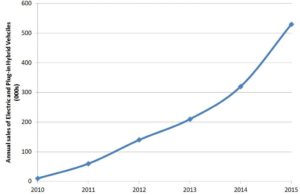
It is predicted that there will be no oil-powered vehicles left in the US until 2023, should the rise of electric vehicles continues at the same pace. Even if this trend is delayed by various political manipulations, the full transition to e-vehicles can just be delayed at most by a few years. On Bloomberg’s chart below you see the three possible scenarios for this trend:
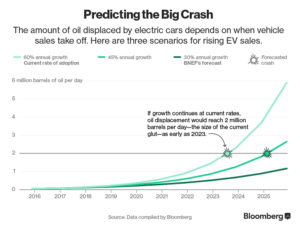
Just this EV transition in the US will save more than 2 million barrels of oil a day. The amount of oil consumed by internal combustion engines today is around 80 million barrels all over the world. Parallel to the US – but coming from behind – the same trend in other geographies will create an even greater oil glut causing a huge crash in oil prices.
I did not find a study that shows the shares of different energy sources into the total energy consumption within the consideration of the electric vehicle revolution. The graph of the European Energy Agency below is drawn without considering the EV revolution. Nevertheless, in this graph it is still anticipated that the share of oil will remain about the same in the coming years with a very sharp increase in LNG demand as a result of the increase in electricity demand:
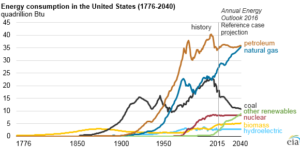
So considering the rise in the electric vehicles shown on the chart of Bloomberg, we can foresee that the graph above shall be revised against petroleum and the rise in the share of LNG will even be steeper.
Oil – instead of being burnt – will be used as raw material for the construction of these vehicles (composite plastics). In order to increase their appeal and usefulness, it will be necessary to install charging stations in each corner, every parking lot and so on. Millions of km of power lines shall be installed for these charging stations.
The description of professions and jobs required in this transition are more specific and limited than ever. Robotics will leave millions of people unemployed, as the vehicle drivers coming first. New Keynesianism can not manage this transition without a strict control and discriminatory measures over immigration.
Therefore if the left will tend to resist to this process, it should delicately determine what to oppose about it in order to be able to come up with a convincing alternative for the masses. The left is however – having been stuck in the abyss of identity politics – far from being able to figure out any holistic political project that could engage the process.
The new Transatlantic-Russia alliance
This Capitalist Revolution and Neo-Keynesianism – contrary to common belief – compels a new and stronger Transatlantic-Russia alliance than it had ever been before. The current crisis, rather than increasing the conflict between the two superpowers, is forcing the Western world and Russia to get into the path of integration. The features of this integration can be observed by countless indications ranging from common secular culture in everyday life to gender equality, flirt culture, rational and scientific education policies that will generate the brain power necessary for Capitalist Revolution, consumption and entertainment habits, clothing, hygiene, and so on. Keeping all these in mind, we will now focus on the new energy geopolitics, which is currently the key agenda for policy makers.
In our two previous studies, we have already explained that the American Shale Gas revolution has inevitably forced US-Russia cooperation to dominate EU market.
The Middle East energy resources are the third largest conventional reserves in the world, after US-Shale-Gas and Russian conventional reserves. Their (Their = Middle Eastern energy reserves) operation must be obstructed so to save the huge investments into Shale Gas operations and to build a new American hegemony on energy. When it comes to Middle Eastern Sunni states, they already do not have any national initiative to operate their own natural resources. Oil and gas are not made out from their land when American companies stop operating their wells.
Russia already dominates Northern and Eastern European markets. It is also on the way to capture and strengthen its Mediterranean market from Algeria and from the Black Sea-Bulgaria, to the Mediterranean Europe. Russia can not tolerate the competition of a third reserve (that is the Middle East). Russia, depending on energy exports, has to bomb every new route of energy that may flow out from the Middle East.
So our anticipation that the Shale Gas Revolution would inevitably bring about a new US-Russia alliance momentum was an indirect conclusion. Hence the developments in 2016 had fully confirmed our prediction.
But in our analysis of last year we missed a new dynamic of cooperation between the two superpowers: Arctic Gases.
Now, in addition to the Shale Gas, a new cooperation on Arctic Gas has emerged as an indication of a direct alliance between two super powers.
Shale Gas + Arctic Gas Alliance against the Mullah Gas
We see here another priceless blessing of global warming: The dominance over Arctic Sea has always been a serious geopolitical target of Russia. And now thanks to the clearing of the Arctic Sea from the ices, Russia having the broadest coastline to this sea is both obtaining an alternative route to warm seas and controlling the shortest trade route between the North Atlantic and the North Pacific. In line with these goals, Russia has developed ice-breaking vessels that would head to commercial and military vessels:


When we look at the planet earth from the right point of view as below, we can see that the Arctic Seaway is shorter than the traditional hot seas way:
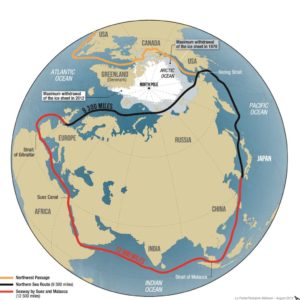
On the other hand, according to the 2008 report of the US Geological Survey Institute (USGS) connected to the US Interior Ministry, the majority of conventional basins (“assessment of undiscovered conventional oil and gas resources”) are located in the Russian exclusive economic zone. And the size of these conventional oil and gas reserves (“conventional here means, unlike Shale Gas, the resources are at closer depths, reachable by traditional drilling technologies) are calculated like around 240 billion barrels in total (oil barrels and the gas equivalent to oil barrel).
Below we see the Arctic Routes cleared by global warming and the locations of gas drilling wells that are currently in operation. The intersection of the drilling sites with the new sea routes makes the Arctic reserves even more operable:
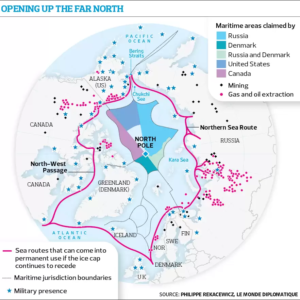
And here are the locations of the estimated reserves in the Russian exclusive economic zone:

On the map above, areas with a probability of at least 50 million barrels of oil and gas equivalent to barrel oil to be found 100% are shown in dark blue.
Russia does not have the necessary technological infrastructure to operate these reserves. This is the reason why the US (or Exxon Mobile) is commissioned. Now in this context that we can understand the rumors about the former Exxon Mobil boss Rex Tillerson’s close relations with Putin and Gazprom and the Russian hacker intervention to US elections. The symbol name of the Transatlantic-Russia alliance will be Rex Tillerson (or T-Rex):

To give a rough idea about the magnitudes: this reserve is equal to 10% of the total gas and oil that can be extracted by conventional methods all over the world (except Shale Gas) and also roughly equal to the total reserves that Russia has today around Siberia. So when Russia starts operating this reserve, it will double its natural gas resource. It is also roughly equal to whole gas reserves concentrated around the Gulf area in the Middle East, where the regressive Shiites of Iran and regressive Sunni states seat on. And again, this reserve equals to about the half of all gas and oil consumed by mankind since 150 years (since the discovery of internal combustion engines).
Hence we must once again see the invalidity of environmentalists’ tailored discourse saying “fossil fuels are exhausting” and once again we must evaluate the new geopolitical dynamics with the consideration of these facts:
1) Gas and oil will not be exhausted – they will at least not be exhausted in a foreseeable future. Sources are almost limitless.
2) Today’s fight is not a fight to control and exploit the limited resources. Today’s fight is the fight to spread the resources that are concentrated in specific geographies to the developed geographies having high potential of consumption, that is, to the geographies of advanced civilizations (mostly Northern lands).
3) For the Capitalist Revolution to build up its above-mentioned new accumulation model depends on its success to install these energy transfer networks that also need to be safely protected by the superpower alliance.
4) Shale Gas and Arctic Gas are safer, more trouble-free operable resources for advanced civilizations – compared to the Middle Eastern resources.
5) For funding the operations and caring the existing investments of both the Shale Gas and the Arctic Gas resources, the Middle Eastern resources must be obstructed.
The energy supplier of Europe’s Atlantic coast will be the United States and the rest of Europe will be fed by Russia. The US will also be the supplier of Japan and Latin America on the Pacific front.
The US-Russia cooperation on the Chinese market is also inevitable and necessary. This is why the US Navy blocks Hormuz Straight: The US blockade in the Indian Ocean, from the Middle East till China, Indonesia, Malacca Straight, Philippines, till Japan, makes Russia the sole supplier of China.
In 2014 Russia and China have signed an agreement targeting gas trade worth to $ 400 billion per year. The completion of the pipeline and the start of the gas flow are targeted for 2019, latest 2020. The news is that China is now somewhat sluggish in the deal, as its growth rate is slowing down and relying on its own Shale Gas investments. But still it is likely that this pipeline will be completed and operated:
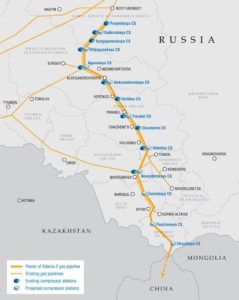
516 km in the Russian territory and 80 km in the Chinese territory out of the 3000km distance in total, have already been completed in 2016. When the flow starts at full capacity, the amount of the natural gas that this pipeline will transfer to China will be equivalent to 237 million barrels of oil per year (38 billion cubic feet). This amount is equivalent to 1/5 (one fifth) of China’s total natural gas consumption (gas equivalent to 1250 million barrels of oil or 200 billion cubic feet gas) in 2016! In other words, given the speed of growth along with the electrical revolution, China’s need for Russian gas can not be underestimated.
The following map shows the energy market geographies of the US and Russia, showing also Russia’s Syrian-Mediterranean wedge and the US’s Hormuz-Indian Ocean wedge:
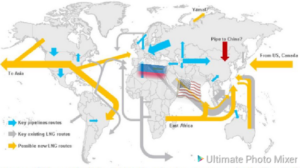
Russian wedge blocks also the fantasy of Iranian-Kurdish corridor to the Mediterranean Sea. In this constellation, founding of a quack Kurdish state without that corridor can not survive, because, just like the Arab geography, this region has also a non-productive economy and it can only survive by wasting away its underground resources to advanced economies. And as we also see on the map, as the US wedge blocks the Chinese way too, what remains behind to define conflict dynamics in the Middle East?
There just remain Tayyip, Netanyahu and Iran factors. And we will now discuss how their positions with the above mentioned global constellation may define the current conflicts in this abyss.
The Abyss in the Middle East
As we have said in our previous articles: no matter what we study, there must always be a map in front of us. Even in a course of literature, there must be a map hanged in front of the students so that those who are not interested in the lectures will look at the map and dream about it instead of being noisy and to learn developing a kind of imagination that does not loose connections with the reality. So, here is the map:
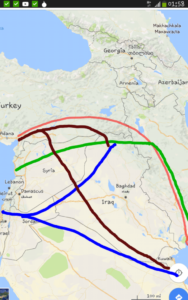
The Red line is Nabucco, that is, the Tayyip + Ahmadinejad + Obama project … This project was avoided by the overthrow of Ahmadinejad in Iran and by Fethullah Gullen’s Community conspiracy-initiative in Turkey. The prize to Iran for the annulment of this project was the removal of the sanctions.
The Green line was the kurdish-corridor project with the Iranian-Kurdish alliance to open up the route to the Mediterranean. This was also canceled by the Russian blockade. At this stage, there is no any obvious logic for still conceiving the Kurdish corridor as a threat. Now neither the US nor Russia will stand behind the Kurdish corridor fantasy. So there can be a single logic behind the limited support that is still given to them: “Better to make them fight around rather than letting them stay in peace”.
The Short Brown line in the North is the Kirkuk-Yumurtalık pipeline. Keeping it to work is very important for Turkey. This is the logic of Barzani – Tayyip flirt.
The Blue line from the North to the South is the first oil pipeline in history: the Kirkuk-Haifa pipeline. This line has been idle since 1948. The re-operation of this line is a very valuable project for the welfare of Israel. This line (like the Kirkuk-Yumurtalık) expresses the interest of Israel and Turkey in the Kirkuk-Mosul region.
The Brown line along the Euphrates River to the South is the energy route that will give a breathe to the regressive Sunni-Gulf states and integrate their economies into Turkey. ISIS is holding this line. The initiative of the Turkish government to establish a joint military block with Saudi Arabia and Qatar can be interpreted within this framework. For the columnists who can not find a satisfactory answer to the question “why our army is in Al-Bab?”, we suggest to think within this framework.
The Long-Blue line in the South is the Israeli version of the Long-Brown line. So again it’s a project out of which the regressive Sunni-Gulf countries may take a breath through integrating their economies into the Israeli economy which would also develop the welfare of Israel … Israel’s flirting with the Sunni states can also be interpreted within this frame.
And over all, when thinking about this constellation, we must keep in mind that all of these lines – as we have told from the beginning – are in total conflict with the Transatlantic-Russia alliance and the general requirements of the new capitalist revolution.
We should also bear in mind that this geography has a “beneficial” aspect in functioning as a human-grinding center, where the depressives, the lumpen-proletariat, nihilists, religious radicals are discharged and destroyed out of the Transatlantic-Russia civilization.
The Transatlantic-Russia alliance will do everything to be done to obstruct this geography to outsource its energy resources to the Western world and China. However, there are only two economies in the region that are partly developed, which will enable local resources to be absorbed within their own economies to improve local industry and prosperity: Turkey and Israel. Could these countries form a peaceful consensus against the Transatlantic-Russia alliance on the basis to share and use local resources without exporting them out? Even if such a compromise is aimed at, what will be the position of Iran in this project? Or will the political vacuum that will soon emerge in the Sunni-Gulf region draw Turkey, Israel and Iran into a catastrophic disaster?
Considering that both countries – far from pursuing Jacobin-Kemalist enlightenment ideals – follow ethnicity and religion-based politics, it is hard to imagine such a peaceful compromise. None of these countries can be a center of attraction for local people, both failing to represent a universalist civilization model. So the human capital of both three states flows to the North and West, on the opposite way to the lumpen flow, coming to fight and die. Under these conditions, the possibility to develop a rational and humane project for enlightenment and prosperity for regional people looks unlikely.
March 18, 2017
This article had been prepared with the contributions of Prof Şener Üşümezsoy.